2024 Appointments
Christian Mitchell

B.S. University of Central Arkansas, 2017
M.S. Texas A&M University, 2021
Mentor: Abdelrahman Fouda, Ph.D
Research Project: Endothelial HDAC3 mediates pathological retinal neovascularization via metabolic reprogramming
Pathological angiogenesis occurs in retinopathy of prematurity (ROP) and the proliferative stage of diabetic retinopathy (DR) the leading causes of blindness in infants and working age adults, respectively. Pathological angiogenesis is triggered by hypoxia resulting in uncontrolled vascular proliferation and the formation of immature and leaky blood vessels. Retinal endothelial cells play a crucial role in pathological angiogenesis under hypoxia. Compensatory glycolysis and mitochondrial fission are both increased in endothelial cells under hypoxic conditions while oxidative phosphorylation is decreased indicating a shift from mitochondrial respiration. The enzyme histone deacetylase 3 (HDAC3) is involved in cellular proliferation and transcriptional repression. Previous data from the lab implicates HDAC3 in retinal pathological angiogenesis. HDAC3 is upregulated in hypoxic retinal vessels and endothelial cells. In vitro treatment of retinal endothelial cells (RECs) with an HDAC3 inhibitor (RGFP966) reduced angiogenesis and mitochondrial fission under hypoxia. Furthermore, inhibition of HDAC3 suppressed the hypoxia-induced expression of the enzyme hexokinase 2 (HK2), a rate-limiting glycolytic enzyme that is upregulated in pathology. Our data indicates that inhibition of HK2 yields comparable results to HDAC3 inhibition. Our future studies will determine if HDAC3 mediates pathological retinal angiogenesis via HK2. We are hopeful this research will lead to new therapeutics for uncontrolled angiogenesis in ischemic retinopathies.
Dakota Redling

B.S. Oklahoma Christian University, 2020
Mentor: Kimberly Stephens, Ph.D., MPH
Research Project: Role of early life stress on epigenome alterations of primary sensory neurons and pain sensitivity
The inability to resolve postsurgical pain within the expected healing window fosters a higher risk of postoperative complications, prolonged opioid usage and increased incidence of opioid addiction, and increases recovery time. Psychosocial and environmental factors in early life are associated with increased risk of chronic pain in later life. Mounting evidence suggests that early-life stress alters somatosensory development and promotes the excitability of primary sensory neurons. These long-lasting effects suggest the involvement of epigenetic mechanisms, but how early-life stress promotes epigenetic changes in sensory neurons is unclear. Our lab uses a well-established model of chronic early life stress (CES) during which normal maternal care behaviors are disrupted. Developing sensory neurons are highly sensitive to frequency and intensity of maternal touch. To provoke the normal transcriptional changes that occur in the context of postsurgical pain, we perform plantar incision of the hind paws. We anticipate that this procedure will trigger maladaptive gene expression in adult dorsal root ganglion (DRG) neurons. We measure evoked responses to noxious stimuli following surgery to evaluate sensitivity differences between CES and control groups. In my dissertation research I will identify and aim to intervene in the aberrant deposition of epigenetic marks which we believe contributes to the increased neuronal excitability in the CES offspring. Ultimately, we aim to understand how CES induces aberrant epigenetic marks to sensory neurons which promotes individual variability in pain sensitivity and susceptibility to developing chronic pain following injury in later life.
Grant Dawson

B.S. Arkansas State University, 2022
Mentor: Lu Huang, PhD
Research Project: Alveolar macrophage metabolism during Mycobacterium tuberculosis infection
Mycobacterium tuberculosis (Mtb), the causative agent of tuberculosis, is one of the leading causes of death. Each year, nearly ten million people are diagnosed with TB, and approximately 1.5 to 2 million will succumb to the infection. Immunometabolism is a rapidly growing field that analyzes how metabolic pathways of immune cells are altered and affect immune function during infection and disease. The Huang lab investigates lung macrophages during Mtb infection to understand how the metabolism of these highly plastic cells influences host response and disease pathogenesis. Diabetes mellitus is a chronic metabolic disorder that affects millions of people and triples the risk of contracting tuberculosis. Previous data suggests that the chronic hyperglycemia associated with diabetes mellitus may influence lung alveolar macrophage metabolism and diminish the host response to TB. My research aims to understand how metabolism of lung macrophages regulates Mtb infection in the context of diabetes mellitus using immunological and genomic approaches. This research is critical for a better understand on how macrophage metabolism impacts TB and will be essential for developing novel host-directed therapeutics for Mtb-infected diabetic patients.
2023 Appointments
Meghan Jones

B.S. University of Arkansas, 2018
M.S. University of Central Arkansas, 2022
Mentor: Jason Stumhofer, Ph.D.
Research Project: The Role of IL-10 in Non-Lethal Plasmodium yoelii Infection
Malaria remains a major global public health problem despite substantial efforts to reduce associated morbidity and mortality. The development of a robust immune response is essential to eliminate the Plasmodium parasites that cause malaria and protect against re-infection. However, this response must be tightly regulated to avoid immune-mediated damage to host tissue. To do this, the host develops regulatory networks that impact the magnitude of the immune response. However, if these networks over-power the protective immune response too quickly, parasites can persist longer, leading to disease. My research project focuses on understanding how the absence of the anti-inflammatory cytokine IL-10 results in a lower parasite burden in mice after infection with non-lethal P. yoelii 17X. Our lab found that this phenotype can be recapitulated with an IL-10R blockade using a monoclonal Ab. In addition, we have found that IL-10-/- mice have increased Ab-producing plasmablasts in the spleen. Thus, we hypothesize that the protection may come from a heightened B cell response. I plan to (1) further characterize the B cell response in the IL-10-/- mice and investigate the contribution of other immune cells to the observed phenotype and (2) determine the window during which IL-10 acts to suppress the protective response. Overall, this project will study the impact of IL-10/IL-10R signaling in response to Plasmodium infection and address how manipulating this pathway can reduce disease burden without inducing tissue pathology.
Katie McGraw

B.S. Lyon College, 2018
Mentor: Nirmala Parajuli, Ph.D.
Research Project: The Role of Complement C5 in the Renal Mitochondria During Ischemia and Reperfusion Exacerbated by Cold Storage
One of the first events to occur in the kidney after ischemia and reperfusion (IRI) is mitochondrial dysfunction, which leads to an increase in ROS and depletion of ATP. The complement cascade is a known mediator of IRI and previous work in kidney epithelial cells has indicated that some terminal pathway derivatives, particularly complement C5 cleavage product C5a, can bind to receptors on mitochondrial outer membranes during oxidative stress (non-IRI model). Prolonged exposure to cold storage (CS), used clinically to preserve renal transplant viability, has also been shown to correlate with IRI severity. We hypothesized that post-reperfusion C5 activation exacerbates mitochondrial dysfunction and injury in kidneys that experience ischemia magnified by static CS. In preparation for this study, we have developed a new global C5 knockout (C5KO) rat model using CRISPR/Cas9 genome editing, which we seek to combine with established surgical models for warm IRI (via clamping) and CS exposure followed by transplantation (CS+Tx). My research is pursuing two specific aims: (1) to investigate the effect of C5 knockout on rat kidney function/injury and mitochondrial function during warm IRI and (2) to define the role of C5 in renal grafts and the effect of C5 knockout on mitochondrial function after CS+Tx. The proposed work will assess C5 as a potential target to mitigate injury to mitochondria and renal tissue during transplantation.
Lindsey Hazeslip

B.S. University of Central Arkansas, 2019
Mentor: Karl Boehme, Ph.D.
Research Project: The Role of Complement C5 in the Renal Mitochondria During Ischemia and Reperfusion Exacerbated by Cold Storage
Viral myocarditis is a significant cause of morbidity and mortality worldwide, particularly in children and young adults. Despite the clinical importance of viral myocarditis, the mechanisms by which viruses cause myocarditis are poorly understood. My project uses mammalian orthoreovirus (reovirus), which is a longstanding model for studying viral cardiac infections in neonates. Our laboratory recently identified a potently myocarditic reovirus strain (T1L/T3DM2) that is highly lethal in neonatal mice. New preliminary data indicates that the virulence of T1L/T3DM2 is diminished in mice lacking a key component of pyroptotic cell death pathway, gasdermin D. Gasdermins are cleaved in response to a myriad of stimuli, including viral infections, and leads to insertion of the gasdermin N-terminal domain into the plasma membrane to form a pore that causes cell lysis. My project will define how gasdermin D contributes reovirus myocarditis. I will examine how gasdermin D impacts reovirus replication, cell death induction, and cardiac pathogenesis using a combination of in vivo and ex vivo models. If successful, my work will have broad applicability as it will further our understanding of how viruses cause disease in the heart and will also inform efforts to generate new therapeutics to treat viral myocarditis, and possibly other cardiac diseases.
2022 Appointments
Charles “Matt” Burnham

B.S. Ouachita Baptist University, 2020
Mentors: Alexei Basnakian, M.D., Ph.D./Intawat Nookaew, Ph.D.
Research Project: Extrachromosomal circular DNA profile and stability in cancer
eccDNA appears to play an elusive role in directing the selective advantage that results in tumor heterogeneity and chemotherapy resistance in cancer. It is currently unknown what cellular environment is necessary for these circular DNA elements to exist and how this may translate to its ability to persist in the circulation. Along with eccDNAs involvement in the selective advantage of cancer cells, we hypothesize that cancer cells provide the optimal environment for the formation of eccDNA due to the low abundance of apoptotic DNases/endonucleases compared to normal cells. Utilizing our robust bioinformatic workflow for identifying these molecules, my research is pursuing two specific aims: (1) to identify eccDNA in vitro, ex vivo and in vivo using a novel CRISPR-mediated mitochondrial DNA linearization technique in preparation for eccDNA enrichment via linear-specific DNases and amplification by ɸ29 polymerase in preparation for next-generation sequencing. (2) To identify the mechanism of endonucleases deoxyribonuclease I (DNase I) and endonuclease G (EndoG) on eccDNA stability utilizing in vitro, ex vivo and in vivo models by modulating them genetically and chemically. This proposed study will identify the mechanism of stability that allows eccDNA to persist in the circulation and assess its candidacy as a potential cancer biomarker, making way for the early detection and treatment of cancer.
Katherine Deck

B.S. John Brown University, 2021
Mentors: Shengyu Mu, Ph.D.
Research Project: Mechanisms of T cell activation and “salt memory” in salt-sensitive hypertension
More than half of American adults suffer from hypertension, which is a leading cause of cardiovascular disease and top contributor of mortality in the United States and worldwide. Although many antihypertensive drug families were developed in the past decades, only about half of the patients have reached blood pressure control. Thus, it is critical to explore unknown mechanisms of hypertension and develop new therapeutic strategies to treat this pathogenesis. In recent years, our lab identified a new mechanism in the pathogenesis of hypertension, that adaptive immunity, in particular CD8T cells (CD8T), stimulates renal distal convoluted tubule cells to promote excessive salt retention, thereby elevating blood pressure (published in Nature Communications). After joining the lab, I participated in experiments immediately and contributed data to support our most recent publication in Circulation Research. In this report, we have determined the critical role of CD8T activation in hypertension and identified key molecules mediating the interactions between activated CD8Ts and kidney tubules. The central hypothesis of my future study builds logically on these exciting findings. We propose to identify the precise mechanisms of CD8T activation in hypertensive kidneys and determine the role of this mechanism in contributing to “salt memory”, which leads to resiliency of salt-sensitive hypertension. Overall, this will not only aid in the current understanding of the pathogenesis of hypertension but will provide new insights on pharmacological targets.
Randall Rainwater

B.S. University of Central Arkansas, 2020
Mentors: Marie Burdine, Ph.D.
Research Project: The role of DNA repair proteins in lymphocytes during TCR activation
Given that organ transplant is the only option for patients in end-stage organ failure, it is imperative that we improve our ability to prevent rejection and extend patient survival. By identifying key molecules involved in the mechanisms that drive transplant rejection, more effective therapies to prevent rejection can be generated. Therefore, our research focuses on defining the function of the promising molecular target DNA-dependent protein kinase catalytic subunit (DNA-PKcs) in the allogeneic immune response to donor organs in order to better understand its potential use as immunosuppression therapy for transplant patients. Our laboratory has shown that DNA-PKcs is critical for the function of T cells which mediate acute transplant rejection. However, the potential use of DNA-PKcs inhibitors in this context requires a complete understanding of the role of DNA-PKcs in mature T lymphocytes. Therefore, the focus of my research project will be to define the role of DNA-PKcs in T cells and identify underlying molecular mechanisms using transgenic mice recently developed in our lab with DNA-PKcs specifically deleted in either CD4+ or CD8+ T cells. We want to determine the effects of DNA-PKcs inhibitors on graft rejection using allogenic in vivo transplant models and generate more specific DNA-PKcs inhibitors/protacs.
2021 Appointments
Luke Childress
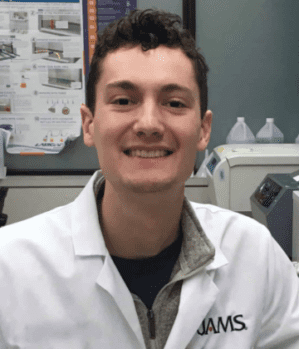
B.S. Dallas Baptist University, 2019
Mentor: Ryan Porter, Ph.D.
Research Project: The role of cellular senescence in cartilage repair
More than thirty-two million Americans are afflicted with osteoarthritis (OA). There is growing evidence from preclinical models that cellular senescence may contribute to the onset of OA due to aging or prior joint trauma. Both subsets of OA are characterized by the degeneration of articular cartilage. Due to its avascular nature, this tissue fails to mount a regenerative response to damage. To date, effective treatments have not been developed to restore cartilage function and prevent progression of OA, which often necessitates joint replacement surgery. The focus of my research project is to identify the roles that cellular senescence plays in poor articular cartilage repair following aging or prior focal injury. Using a rat model of cartilage injury, we will identify the contribution of systemic and local (intra-articular) senescent cells to cartilage healing by delivery of drugs which selectively eliminate senescent cells. We will also seek to understand the role of the paracrine/endocrine actions of senescent cells on cartilage repair cells by inhibiting key secretory pathways. The final goal of this project is to evaluate a sustained intra-articular drug delivery system to effectively target regeneration-inhibiting actions of local senescent cells. This project has implications in preventing loss of joint mobility through improved treatment of cartilage injuries.
Lucy Fry

B.S. Florida State University, 2020
Mentor: Tiffany Weinkopf, Ph.D.
Research Project: VEGF-A/VEGFR signaling in macrophages during Leishmania infection
Leishmaniasis is a vector borne disease caused by the protozoan parasite Leishmania. There are 1-2 million new cases of leishmaniasis each year endemic to poorer regions of the world. Previous work from our lab has implicated a role for the VEGF-A/VEGFR signaling pathway during Leishmania infection. The VEGF-A/VEGFR signaling pathway leads to lymphangiogenesis which results in lesion resolution during Leishmania infection. Macrophages, the replicative niche for Leishmania parasites, have been shown to produce the ligand as well as the receptor for the VEGF-A/VEGFR signaling pathway. My project aims to understand how this signaling pathway is modulating the host macrophages during infection along with the potential effects it may have on the innate immune response as a whole. We have currently utilized RNA sequencing to compare the transcriptomic profiles of bone marrow-derived macrophages (BMDMs) stimulated with VEGF-A to controls and observed that BMDMs treated with VEGF-A have decreased parasite numbers after 72 hours. We plan to continue this research using an in vivo murine model and further elucidate the significance of VEGF-A/VEGFR signaling during Leishmania infection.
Jacob Edmondson
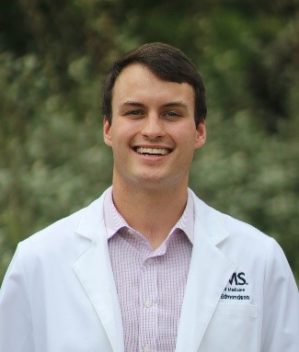
B.S Ouachita Baptist University, 2019
Mentor: Alan Tackett, Ph.D
Research Project: Activating ER stress to restore MHC expression in Metastatic Melanoma
Immune checkpoint inhibitors (ICIs) initially offer a promising treatment option for metastatic melanoma and are often utilized as first-line therapy. ICI effectiveness is largely linked to the immunogenic profile of tumor cells and a primary reason why many patients fail to realize long-term clinical benefits. Previous data have shown that changes in tumor metabolism can affect MHC antigen presentation, a critical component of the immune response to cancer and effective ICI therapy. My current work is focused on understanding the role of glucose withdrawal in the activation of the adaptive unfolded protein response (UPR), and characterizing the implication of the UPR in defining the immunogenic state of melanoma cells. This project aims to determine the mechanism of interaction between the UPR and antigen presentation, and how the UPR alterations change the diversity of MHC-bound antigens. We plan to manipulate the efficacy of the UPR in a variety of cell lines and murine models to determine key regulators of immunogenicity in malignant melanoma. These key regulators will be scrutinized as potential candidates for adjuvant therapy to improve the efficacy of Immune Checkpoint Inhibitors.
2020 Appointments
Lance Benson

B.S. Harding University, 2018
Mentor: Shengyu Mu, M.D., Ph.D
Research Project: Pathogenesis of salt sensitive hypertension
Hypertension is a leading cause of cardiovascular disease both in the United States and worldwide, but the mechanisms underlying its pathogenesis are only partially understood. Previous studies from our lab have indicated the immune system (particularly CD8+ T cells) plays a role in the development of salt-sensitive hypertension. My project aims to elucidate the mechanism by which CD8+ T cells home to the kidney and stimulate the Na-Cl co-transporter (NCC) within the distal convoluted tubule (DCT) to lead to excessive salt retention. We plan to utilize several mouse models to study the potential role of known cytokines –and subsequent signaling pathways- involved in T-cell homing. Following identification, these signaling molecules will be studied to determine potential targets for therapeutic treatment. Histone modifications in CD8+ T cells and regulatory T cells will also be considered for their potential role in CD8+ T cell activation and subsequent development of salt-sensitive hypertension.
Kalee Holloway
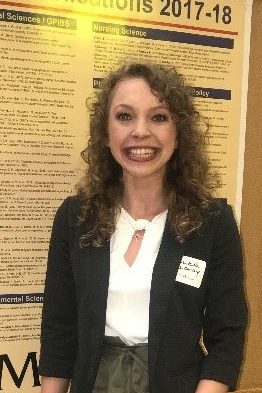
B.S. Henderson State University, 2018
Mentor: Paul D. Drew, Ph.D
Research Project: Ethanol induced neuroinflammation in models of fetal alcohol spectrum disorders.
Fetal Alcohol Spectrum Disorders (FASD) occurs in roughly 5% of live births in the U.S. FASD is the most common cause of mental retardation and there currently is no cure. FASD results from ethanol exposure to the developing brain. Early postnatal rodent models, which are equivalent to human in utero, third-trimester of fetal alcohol exposure, have demonstrated that ethanol exposure during development leads to neuroinflammation including microglia and astrocyte activation as well as increased proinflammatory cytokine and chemokine expression and neurodegeneration. It has also been shown that anti-inflammatory agents can block the effects of ethanol-induced neuroinflammation and protect against neuron loss. With this knowledge, I will be using rodent models of FASD to understand the mechanisms of FASD pathogenesis, focusing on the ongoing pattern of ethanol-induced neuroinflammation, glia-neuron interactions, neuron loss, and the role of defined cell types in ethanol-induced neuroimmune signaling and neuropathology. These changes in brain development will help me to define the ethanol effects on the transcriptome during the transition to FASD neuropathology.
Ravi Sun

B.E. Stevens Institute of Technology, 2017
Mentor: Graham Strub, M.D., Ph.D.
Research Project: Identification and characterization of microRNA networks driving vascular malformation growth
This project aims to develop novel microRNA-based therapies for the treatment of vascular anomalies. MicroRNAs (miRNAs) are short, non-coding RNA molecules that inhibit translation by binding to messenger RNAs, thereby preventing protein synthesis and effectively silencing gene expression at the post-transcriptional level. Vascular anomalies such as hemangiomas, venous malformations, arteriovenous malformations, and lymphatic malformations are characterized by aberrant endothelial cell proliferation. These lesions can be life threatening due to their proximity to and invasion of critical structures. Treatment for these lesions has typically been surgical excision or sclerotherapy. However, complication rates and local recurrence remain a major challenge. This project aims to characterize the miRNA profile of vascular anomaly endothelial cells with the goal of developing an in vivo model of miRNA inhibitor administration targeting the miRNAs that drive aberrant endothelial cell proliferation.
2019 Appointments
Francesca LoBianco
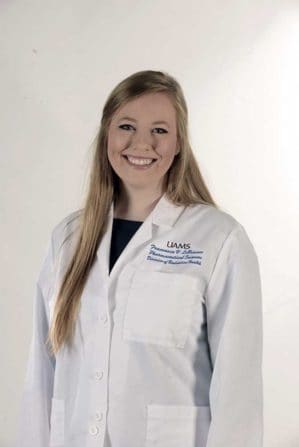
B.S., Lyon College, 2015
M.S., University of Arkansas for Medical Sciences, 2017
Mentor: Nukhet Aykins-Burns, Ph.D.
Research Project: Targeting redox metabolism for the treatment of liver cancer
My doctoral research will examine the redox metabolism mechanisms in the tumor reducing, a naturally occurring plant based small molecule, parthenolide for treatment of hepatocellular carcinoma. This project will use an in vivo hepatocellular carcinoma model as well as in vitro redox mechanism assessment. The research project plans to include various imaging modalities including, MRI/MRS, ultrasound, bioluminescence, image guided embolization, matrix-assisted laser desorption/ionization (MALDI MS) and the small animal radiation research platform (SARRP), to both examine tumor burden and tumor response to locoregional therapy. An important goal to this project is to decrease toxicity and improve tolerance of liver cancer patients to their cancer therapy. My main research interests are focused on oxidative stress mechanisms that lead to normal tissue injury during the various cancer therapy modalities including interventional radiology imaging, radiation therapy, and pharmacotherapeutics.
Joel Vazquez

B.S., St. John’s University, 2018
Mentor: Mitchell McGill, Ph.D.
Research Project: Identification of biomarkers for liver injury
Drug-Induced Liver Injury (DILI) is a leading cause of Acute Liver Failure (ALF) in the United States, with Acetaminophen (APAP) being the major contributor to this class of liver injury. Alanine Aminotransferase (ALT) is currently the gold-standard biomarker used to detect liver injury in the blood, however ALT is not specific to liver injury, as it is expressed in several tissues throughout the body, and cannot distinguish different types of liver injury. In our research, our goal is to find better biomarkers that are specific to liver injury, with a major goal being to find a biomarker that is diagnostic of the type of liver injury by using proteomics and unique mouse models to test and validate these biomarkers. If good biomarker candidates are verified, these biomarkers could potentially be used in the clinical setting for diagnosis, as well as the regulatory setting to improve the process of clinical testing, possibly reducing the number of effective drugs that get denied due to high ALT levels in clinical trials.
Anveshi Guha

B.A., Vassar College, 2015
Mentor: Charles O’Brien, Ph.D.
Research Project: Wnt signalling in glucocorticoid-induced osteoporosis
Glucocorticoids are among the most common causes of osteoporosis, and have been shown to reduce bone formation rates and increase osteoclast number; however, there is limited understanding of the mechanisms by which these changes occur. One of the major pathways affected by glucocorticoids is canonical Wnt signaling, which is involved in osteoblast differentiation and regulation of osteoclastogenesis. There is therapeutic need to uncover ways of mitigating the detrimental impact of glucocorticoids on bone, in order to reduce iatrogenic induction of osteoporosis in the large population of patients under chronic steroid treatment. The aim of this project is to determine whether robust activation of the Wnt signaling pathway can overcome glucocorticoid-induced reduction in bone formation and bone mass. To accomplish this, a mouse model will be generated with beta-catenin, the final signal transducer in canonical Wnt signaling, constitutively active under the temporal regulation of doxycycline. Mice will then be treated with prednisolone, and dual-energy X-ray absorptiometry (DXA), micro–computed tomography (µCT), and histomorphometric measurements will be used to study the effects on bone.
2018 Appointments
Caitlin Caperton
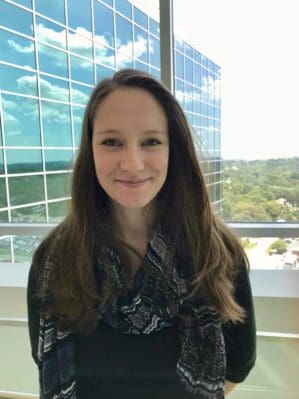
B.A., University of Arkansas at Little Rock, 2015
Mentor: Aime Franco, Ph.D.
Research Project: Immune microenvironment and stromal remodeling associated with follicular thyroid cancer
Thyroid cancer is one of the most rapidly increasing cancers in the US and is predicted to become the 4th most commonly diagnosed malignancy by 2030. Thyroid cancer and related pathologies are often associated with activating mutations in effectors of the MAPK pathway. These mutations are linked to changes in the tumor microenvironment, including migration of non-malignant cells and alternations in the extracellular matrix, that are believed to promote thyroid cancer and eventual progression to poorly differentiated disease. My project seeks to identify how Hras mutations associated with follicular thyroid carcinoma lead to changes in the tumor microenvironment and recruitment of immune cells that allow for tumor growth and progression. Later work will determine whether treatment with Mek or PI3K inhibitors can prevent the recruitment of the cells that we believe drive tumor development.
Melissa Clemens

February 17, 1981 – May 24, 2020
SPaT students and faculty were saddened by Melissa’s untimely death. She was an excellent student and hoped to graduate in spring 2021. We will miss her as an integral part of our department and training program.
B.S., University of Central Arkansas, 2004
MPH, University of Arkansas for Medical Sciences, 2016
Mentor: Mitchell McGill, Ph.D.
Research Project: Mechanisms and biomarkers of liver regeneration after APAP-induced hepatotoxicity.
Acetaminophen (APAP) overdose is the major cause of acute liver failure (ALF) and ALF-related deaths in the US. The standard-of-care treatment for APAP hepatotoxicity is N-acetylcysteine (NAC). However, NAC loses efficacy ≥16h after overdose and nearly half of all APAP overdose patients present later when the only option is liver transplant. Interestingly, the liver has the ability to regenerate as much as 80% of its functional mass after injury and regeneration is critical for survival of ALF patients. Therefore, enhancement of regeneration is a promising treatment approach for APAP overdose patients. Unfortunately, the mechanisms of regeneration after APAP-induced hepatotoxicity are poorly understood. Our lab recently demonstrated that the lipid phosphatidic acid (PA) is increased in the liver after APAP overdose and enhances regeneration signaling. We further determined that the increased PA is due to suppression of lipin enzymes, which metabolize PA. Building on this knowledge, we plan to determine the mechanisms by which PA is regulated and promotes liver regeneration with hopes of identifying new drug targets.
Allie Davis

B.S., Henderson State University, 2017
Mentor: G. Paul Miller, Ph.D.
Research Project: Structure activity relationships in the bioactivation of halogen-containing drugs and its role in drug-induced hepatotoxicity.
The goal of this project will utilize both clinical data and experimental approaches to assess how inclusion of halogens in established drugs, investigational drugs, and new molecular entities affects metabolic generation of quinones and subsequent drug-induced liver injury (DILI). Through a collaboration with the National Center for Toxicological Research, we have gained access to a comprehensive library of pharmaceutical and clinical data that reports prevalence and severity of adverse drug reactions. We will use this information to identify halogenated compounds known to have varying degrees of DILI risk, halogenated compounds known not to cause DILI, and halogenated compounds whose risk of DILI is unknown. We will conduct experiments to assess the relevance of quinone-producing pathways in vitro and compare our findings to reported clinical data to evaluate how quinone concentrations extrapolate to likelihood and severity of DILI. Similarly, we will study pharmaceutical derivatives with different halogenated and nonhalogenated substituents to determine how steric, electronic, and chemical effects influence specificity and affinity of metabolizing enzymes and how those modifications direct bioactivation and detoxification pathways in the liver. This information can be used to identify which families and classes of halogenated pharmaceuticals are most problematic to proper liver function and, in turn, contribute to minimization of DILI risk.
2017 Appointments
Kyle Urquhart

August 23, 1985 – July 22, 2019
SPaT students and faculty were deeply saddened by Kyle’s death. He was a promising scientist nearing the completion of this dissertation studies. Kyle will always be in our thoughts.
B.S. Genetics B.S. Biology, University of Georgia, 2009
Mentor: Bill Fantegrossi, Ph.D.
Research Project: Tolerance and Dependence Liability to Fentanyl Analogues
Fentanyl analogues are emerging drugs of abuse fueling the current “opioid crisis” in the US. The pharmacological properties of many of these novel fentanyl analogues are largely unknown, but a basic tenet of pharmacology is that even small alterations to a drug’s structure may have large effects on its biological effects. Our lab is pioneering in vivo studies of these novel fentanyl analogues to assess their abuse liability and overt toxicity, and my project is specifically focused on characterizing tolerance to their antinociceptive effects, respiratory depressant effects, and effects on operant behavior, as well as dependence and withdrawal elicited by these fentanyl derivatives after repeated administration. In these studies I assess behavioral endpoints in mice and investigate their underlying cellular mechanisms. Among traditional opioids, tolerance to abuse-related effects develops with increased use, and as tolerance develops, the dose must be increased to achieve the same level of sought-after effects. Since the development of tolerance to respiratory depressant effects occurs at a much slower rate than tolerance to reinforcing and antinociceptive effects, many deaths occur as users increase their dose over time. On a related note, dependence produces many adverse effects that prolong use in opioid users, and this prolonged use facilitates tolerance development. In dependent individuals, opioid abstinence produces an aversive withdrawal syndrome that may motivate them to resume drug use. Among the novel fentanyl analogues, higher affinity for mu-opioid receptors may render antagonist-based overdose medications less effective than expected, compared to standard opioids. It is therefore imperative to obtain more information on each of these factors and the role they play in opioid abuse, the mechanisms behind them, and the interactions among them. Using a comprehensive systems-level approach we will assess the potency and effectiveness of these drugs to elicit respiratory depression, determine what doses of naloxone are necessary for the reversal of this effect, gauge the contribution of tolerance and dependence to opioid abuse and their interaction, and investigate specific cellular signaling mechanisms mediating these effects.
Laura Ewing

B.S., University of Arkansas at Little Rock, 2005
M.S., University of Oklahoma, 2007
Mentor: Igor Koturbash, Ph.D. & Annie Lumen, Ph.D. (NCTR)
Research Project: Influence of dietary methionine an dradiation on normal tissue toxicity
The focus of my project is to investigate the modulatory effects of dietary methionine (Met) on health outcomes during radiotherapy (RT) through both animal experimentation and physiologically-based pharmacokinetic (PBPK) modeling. Met, like other methyl donors, can reverse the loss of DNA methylation induced by ionizing radiation (IR) and decrease its oxidative potential. Our preliminary data shows that higher Met intake, comparable to a Western diet, in combination with RT, results in altered gut physiology, reduced function of tight junction proteins, a shift in the intestinal microbiota from commensal to pathogenic flora, and decreased concentrations of Met and its metabolites in enterocytes. These results imply that, although Met is an essential amino acid, toxic effects are observed with Met overload that are exacerbated with exposure to IR. To investigate the changes in intestinal integrity, I will combine animal models of IR exposure and Met with physiologically-base pharmacokinetic modeling to track Met throughout the body. I will also analyze tissue samples from the mice to measure protein synthesis, including production of metabolites of Met, gene expression in intestinal epithelium, and DNA methylation after varying combination doses of IR and Met.

Brian Koss
B.A., Hendrix College, 2008
Mentor: Alan Tackett, Ph.D.
Research Project: Eliminating effects of EZH2 inhibition on melanoma infiltrating lymphocytes
Unleashing antitumor lymphocytes through checkpoint inhibition and adoptive cell therapies are incredibly promising strategies to fight melanoma. It is known that the extreme conditions of the tumor environment greatly reduce the immune response and function of infiltrating cells. New approaches to combat the tumor suppression of an immune response in solid tumors are needed to overcome this barrier. The histone methyltransferase EZH2 (Enhancer of zeste homolog 2) has been shown to mediate survival signaling in tumors and hematopoietic cells, making them resistant to environmental stress. Small molecule inhibitors are currently in clinical trials for treatment of various malignancies. Combination of EZH2 inhibitors with immunotherapies are promising, but limited, due to the requirement for EZH2 in lymphocyte activation and function. The goal of my work is to use a systems biology approach to identify changes in lymphocyte survival pathways during EZH2 inhibition. The findings will be used to develop strategies to eliminate the off-target effects of EZH2 inhibition on lymphocytes in a model of mouse melanoma.
2016 Appointments
Dolapo Adejumobi
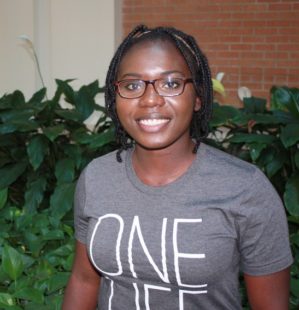
B.S., University of Arkansas at Little Rock; B.A., University of Arkansas at Little Rock, 2014
Mentor: Richard Kurten, Ph.D.
Research Project: Mucosal barrier function in human esophageal mucosa
Eosinophilic Esophagitis (EoE) is an inflammatory disease triggered by food antigens. It is thought that enhanced permeability of the esophageal mucosal barrier leads to submucosal penetration of food antigens and thereby contributes to disease pathogenesis. To evaluate this hypothesis, we are evaluating the permeability of human esophageal mucosa ex vivo using fluorescent tracers. We aim to identify disease relevant inflammatory mediators enhancing mucosal permeability and to understand the corresponding structural alterations in epithelial cell adhesion and tight junctions. We think that understanding how esophageal mucosal barrier function is suppressed in disease could contribute to the development of new therapeutic options for EoE patients. Supported by T32 GM106999

Brittney Garner
B.S., East Texas Baptist University, 2015
Mentor: Nancy Rusch, Ph.D.
Research Project: Ion channel abnormalities in lymphatic smooth muscle cells during experimental lymphedema.
Cancer-related lymphedema is an accumulation of fluid in the interstitial tissue that may result from radiation and/or surgery. Lymph vessels (LVs) play a vital role in maintaining fluid homeostasis by returning extracellular fluid from tissues back to the venous circulation. The distal-to-proximal flow of lymph fluid is accomplished by rhythmic contractions of LVs mediated by finely tuned Ca2+ signaling pathways in the lymphatic smooth muscle cells. Disruption or cessation of LV rhythmic contractions can result in excess fluid in the tissues, which is evident as lymphedema. Although it is known that L-type Ca2+ channels play an important role in LV contractions, the functions of other ioni channels in the lymphatic vasculature are poorly understood, especially during the pathological state of lymphedema. My research project will use an in vivo approach to characterize functional abnormalities of ion channels using a model of surgical lymphedema to help identify a potential therapeutic target to restore normal fluid homeostasis. Supported by T32 GM106999
Ryan MacLeod

B.S., University of Arkansas at Fayetteville, 2014
Mentor: Charles O’Brien, Ph.D.
Research Project: Develop a novel approach to suppress bone resorption through the inhibition of RANKL by utilizing the CRISPR-Cas9 system.
Osteoporosis is a pathological imbalance in the osteoclastic and osteoblastic remodeling of the skeletal trabeculae. It is caused by an increased stimulation of osteoclast formation and subsequent bone resorption by these excess osteoclasts. They cytokine responsible for stimulating osteoclast formation is receptor activator of nuclear factor kappa-B ligand (RANKL), and its increased expression in pathological bone loss has been demonstrated in the past. Existing osteoporosis therapies, such as bisphosphonates, have many adverse side effects. Therefore, new ways to suppress osteoclast formation are needed to improve patient care and the overall outcome of treatment.The goal of my project is to develop a novel approach to suppress bone resorption through the inhibition of RANKL by utilizing the CRISPR-Cas9 system. Once we determine the correct single guide RNA to utilize for the RANKL gene, we will develop a new transgenic mouse model that will express the sgRNA and the Cas9-KRAB selectively in osteocytes. The final stage of my project will be to determine fi the transgene blocks pathological bone resorption using an ovariectomy mouse model to simulate post-menopausal estrogen loss. Supported by the UAMS Translational Research Institute and College of Medicine

Samantha McClenahan
B.A., Vassar College, 2013
Mentor: Mike Owens, Ph.D.
Research Project: To discover and test high affinity monoclonal antibodies against two toxic cathinones (MDPV/αPVP) for use in treating cathinone use disorders.
Synthetic cathinones are medically dangerous psychoactive drugs of abuse commonly known as bath salts. While their desired stimulant effects are in some ways similar to cocaine and amphetamines, synthetic cathinone abuse can lead to cardiovascular toxicity and severe adverse effects including hallucinations, psychosis, and suicidal actions. The goal of my research is to discover and test high affinity monoclonal antibodies against two toxic cathinones (MDPV/αPVP) for use in treating cathinone use disorders.Our studies are focused on evaluating the pharmacokinetics and cardiovascular effects of MDPV and the potential therapeutic use of anti-MDPV antibodies. Supported by T32 GM106999
2015 Appointments

Bill Hyatt
B.A., Hendrix College, 2012
Mentor: William Fantegrossi, Ph.D.
Research Project: Abuse-related and persistent behavioral effects of synthetic cathinone 3,4-methylenediooxypyrovalerone and its enantiomers in rodents
In recent years, a surge of new designer drugs have become widely available in the US, and world, markets. Among those often found in the news is the synthetic cathinone 3,4-methylenedioxypyrovalerone (MDPV). MDPV has emerged as a deadly psychostimulant-like drug of abuse commonly found in commercial ‘bath salt’ preparations. We intend to determine the abuse-related behavioral profiles of racemic (RS), (R) and (S) isomers of MDPV, as well as investigate any persistent behavioral effects. Characterization of behavioral effects of MDPV, paired with pharmacokinetic and toxicity profiles, are crucial in establishing preclinical criteria for development and testing of novel therapy efficacy. Supported by the UAMS Translational Research Institute and College of Medicine.
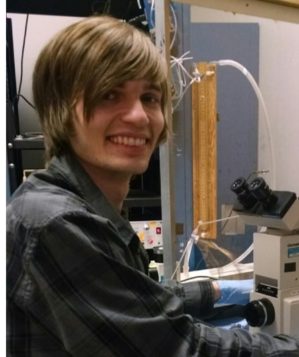
Stephen Shrum
B.A., Hendrix College, 2014
Co-Mentors: Lee Ann MacMillan-Crow, Ph.D./Nancy Rusch, Ph.D.
Research Project: Activating the mitochondrial calcium-activated large conductance potassium channel as a targeted therapy for reducing ischemia-reperfusion injury in renal transplantation
Donor kidneys having undergone cold storage and transplantation (CS/Tx) sustain ischemia-reperfusion (I/R) injury, leading to extensive morphological renal damage, impaired kidney function, mitochondrial damage, and ultimately less successful grafts. Activation of the mitochondrial isoform of the calcium-activated large conductance potassium (mBK) channel was recently shown to have a preconditioning cytoprotective role in I/R injury. However, the mBK channel is uncharacterized in the context of renal CS/Tx. Using an in-vivo rat model, my project investigates novel activity abnormalities of the mitochondrial calcium-activated large conductance potassium channel (mBK channel) that occur during cold storage and renal transplantation. The overarching goal of this project is to develop a mBK channel-targeted therapy for improving renal function following transplant. Supported by American Heart Association Predoctoral Fellowship Award
Julia Tobacyk

B.S., Louisiana Tech University, 2014
Mentor: Lee Ann MacMillan-Crow, Ph.D.
Research Project: Implications of mitochondrial dynamics in renal cold storage following transplantation
Long-term graft viability continues to be problematic after transplantation, especially in kidneys that require cold storage (CS). Studies show that renal CS leads to increased mitochondrial injury in kidneys following transplantation. Mitochondria are dynamic organelles, which continually undergo morphological changes, including fission and fusion. In many diseased states, there is a clear imbalance in mitochondrial dynamics. The scientific premise of my project is to identify pathways involved in mitochondrial fission and fusion using in vitro and in vivo rat renal cold storage and transplant models. Supported by T32 GM106999
2014 Appointments
Chuck Hay

B.S.S., Cornell College, 2010
M.S., University of Nebraska Medical Center, 2012
Co-Mentors: Eric C. Peterson, Ph.D./Michael Owens, Ph.D.
Research Project: Using adeno-associated viruses to express monoclonal antibody fragments to treat methamphetamine and amphetamine addictions
Methamphetamine (METH) abuse often leads to serious addiction, yet there are currently no FDA-approved treatments to treat this addiction. For my project, I will be using adeno-associated viruses (AAV) to induce long-term but transient expression of monoclonal antibody fragments (AAV-scFvs), which recognize METH and its active metabolite, amphetamine (AMP). We envision that these AAV-scFV will reduce or block physiological and behavioral effects of METH and AMP in rat models of acute and chronic METH abuse. Supported by T32 GM106999 (2014-2016).
Lascelles Lyn-Cook

B.S., University of Arkansas at Little Rock, 2009
M.S., University of Arkansas for Medical Sciences, 2012
Co-Mentors: Alison Harrill, Ph.D./Philip Mayeux, Ph.D.
Research Project: Diversity outbred mice may improve preclinical screening for drug-induced liver injury (DILI)
Drug toxicity is the major adverse event leading to drug attrition during development and withdrawal from the marketplace. Unfortunately, liver toxicity is often difficult to predict with current preclinical models. One reason for poor prediction may be that conventional models lack genetic diversity. The Diversity Outbred (DO) mice comprise a genetically diverse population with genetic variability that is actually greater than the human population. We hypothesized that the DO mice, when used in preclinical drug screening, would accurately predict human relevant liver toxicities that conventional models missed. We have selected one drug – zileuton – for mechanistic assessment. We will perform metabolomics and transcriptomics analysis in the liver of sensitive and resistant DO mice to ascertain molecular changes that occur in susceptible individuals. Supported by T32 GM106999 (2014-2016)
Daniel Meeker

B.S., Harding University, 2012
Mentor: Mark Smeltzer, Ph.D.
Research Project: Developing a targeted nanotherapeutic approach to the treatment of biofilm-associated Staphylococcus aureus infections
The ability of Staphylococcus aureus to form a biofilm presents a serious clinical problem, often complicating treatment beyond the use of systemic antibiotics alone. This project focuses on the use of novel nanocages, the incorporation of antibiotics into the nanocages, and the conjugation of nanocages to antibodies specific to S. aureus. The goal is to develop a targeted therapy that allows for highly localized concentration of antibiotic and couples it with a photothermal effect of irradiated nanocages. Further, the potential toxicity of this nanotherapeutic approach will be evaluated to determine the therapeutic viability of our model. Supported by T32 GM106999 (2014-2015)
2013 Appointments
Alex Alund

B.S., University of New Haven 2012
Mentor: Martin Ronis, Ph.D.
Research Project: The role of NADPH oxidase 4 and oxidative stress in alcohol-induced bone loss
Chronic alcohol consumption and binge drinking are two major risk factors for osteoporosis and low bone mass. Alcohol-induced bone loss is driven by an increase in intracellular levels of reactive oxygen species (ROS) through induction of NADPH oxidases (NOX). We are specifically studying the role of NOX4, hypothesizing that it is at the head of a cascade that produces NOX-derived ROS as a result of alcohol metabolism in osteoblasts. Our studies are also looking at the potential of dietary antioxidants as a therapeutic intervention for alcohol-induced bone loss. Supported by T32 GM106999 (2013-2015)
Emily Holthoff

B.S., Ouachita Baptist University, 2011
Mentor: Steve Post, Ph.D.
Research Project: Perineural invasion as an indicator of clinical outcome in vulvar squamous cell carcinoma
Vulvar squamous cell carcinoma (vSCC) is a disfiguring malignancy of the female genital tract with a particularly high incidence in the state of Arkansas. We are investigating the role of perineural invasion as a potential indicator of tumor aggressiveness and prognosis for clinical pathologists confronted with cases of vSCC. We are also exploring the molecular interactions between tumor cells, nerve cells, and inflammatory infiltrates in these tumors to determine the mechanism by which perineural invasion occurs. Supported by the UAMS Translational Research Institute (2013-2014)
Clark Sims

B.A., Hendrix College, 2012
Mentor: Philip Mayeux, Ph.D.
Research Project: Targeting renal perfusion and mitochondrial oxidants in a model of infant sepsis
Sepsis is the eighth leading cause of infant mortality in the U.S. and also is prevalent worldwide. Sepsis-induced acute kidney injury is a frequent complication of infant sepsis and increases the mortality rate from 25% to nearly 45%. Currently, there are no effective therapies to treat sepsis in infants and clinicians must rely only on supportive care usually initiated only after the presence of symptoms. Clark will be evaluating two new therapeutic targets in an animal model of pediatric sepsis. Clark was supported by T32 GM106999 (2013-2014) and is currently supported by an NRSA F31 award from NIDDK.
